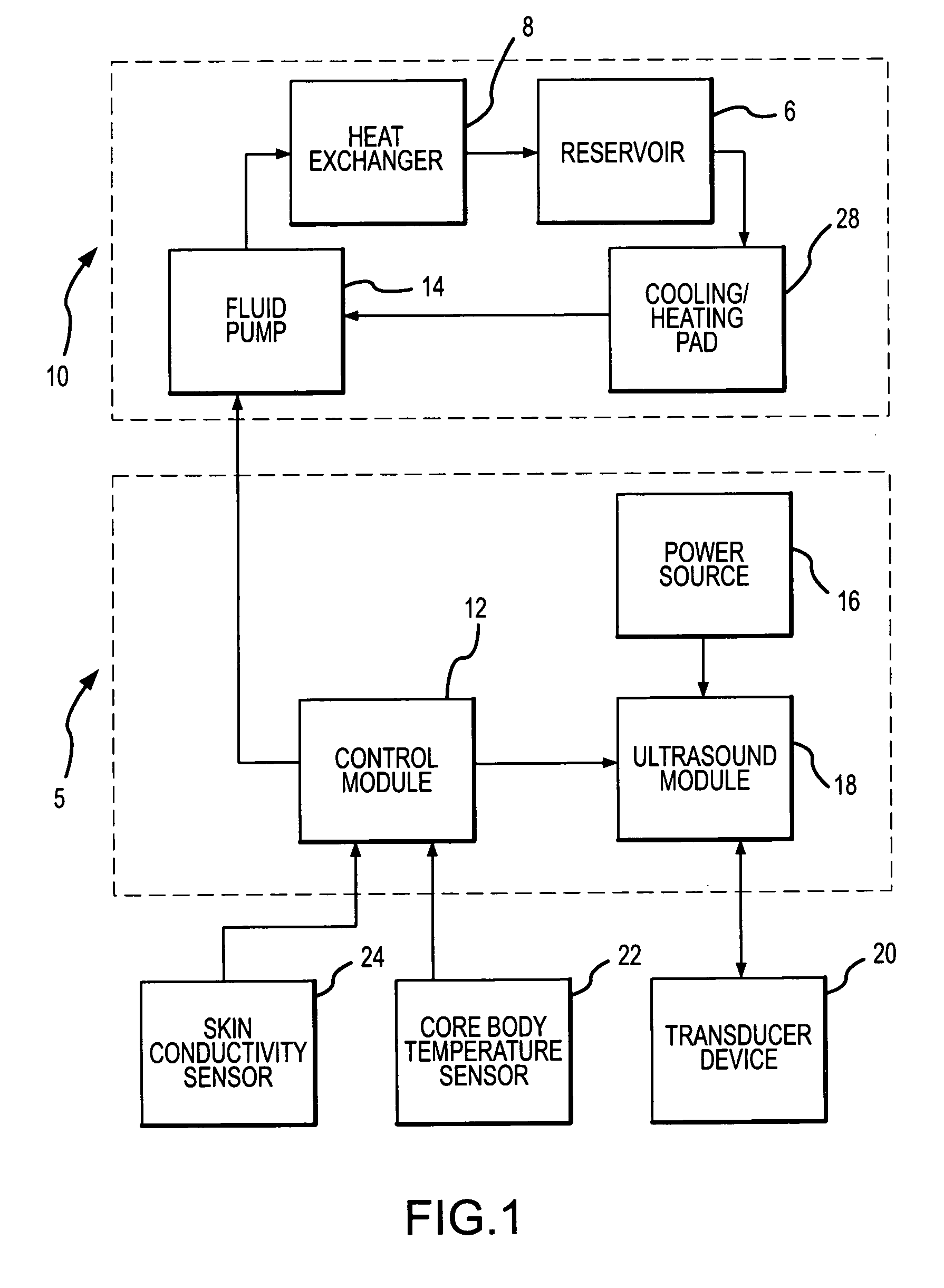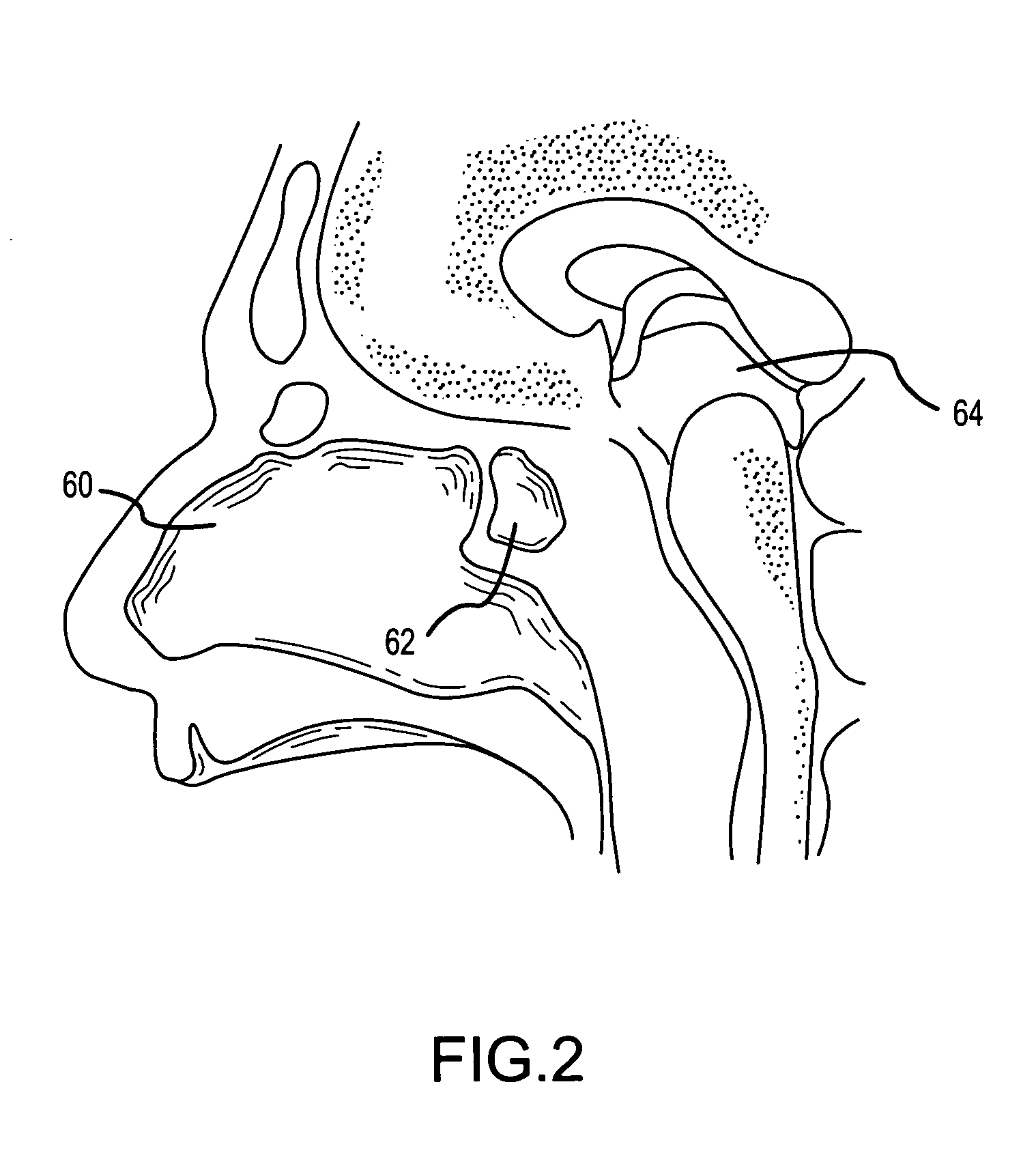[0004] In conjunction with the present invention, it has been recognized that
ultrasound energy may be utilized to heat the POAH in order to induce mild
hypothermia in a patient. For example, such
ultrasound energy may be emitted through one or more transcranial windows in order to extracorporeally heat the POAH. Such transcranial windows may include thin portions of the
skull as well as openings within the
skull. As will be appreciated, by focusing
ultrasound energy of a predetermined frequency range and magnitude (i.e., power) on the POAH, thermoregulatory responses (e.g.,
shivering and / or
vasoconstriction) of the patient may be overcome thereby facilitating the use of external cooling to a reduce a patient's core body temperature.
[0005] According to a first aspect of the present invention, a method for inducing mild
hypothermia within a patient is provided wherein ultrasound heating of the POAH is combined with artificial cooling of a patient's body to enhance the rate at which such
hypothermia is induced. In this regard, the method includes positioning a source of ultrasound energy relative to a patient's skull and applying ultrasound energy to the POAH to affect thermoregulatory responses of the body. In conjunction with application of the ultrasound energy to the POAH, one or more portions of the patient's body is cooled using an artificial cooling means in order to remove body heat. The combination of POAH heating with artificial cooling allows a patient's core body temperature to be rapidly lowered.
[0008] The cooling pads may allow for direct fluid contact with a patient's
skin. That is, these cooling pads may comprise a membrane that fits on / over a portion of the patient's body such that fluid may circulate in a space between the membrane and a patient's
skin. In this regard, a combination of convective and conductive
heat transfer may be utilized to remove heat from the patient's
skin. To prevent leakage from such membranes, fluids may be circulated under a negative pressure. In this regard, the negative pressure may allow the edges of the membrane to form a better seal with a patient's skin to prevent fluid leaks. Alternatively, such pads may be closed systems wherein one or more channels pass through the pad, that allow fluids to be circulated therethrough. In this regard,
thermal energy may be exchanged with a patient through conductive contact with the pad. To enhance this conductive contact, the pad may be adhered directly to the patient's skin and / or utilize a gel, ointment or other medium to enhance
heat transfer between the pad and the patient's skin. In one embodiment, the pad includes an adherent surface provided by a thermally conductive hydrogel layer juxtaposed to a
fluid circulation layer. As with the membrane type cooling pads, fluids may be circulated through such
closed system pads under negative pressure to provide enhanced circulation. When negative circulation pressures are utilized, the cooling pads (i.e.,
closed system and membrane type) may require internal structure(s) to maintain an adequate fluid flow path.
[0009] In one embodiment, that may be particularly apt for use with
stroke patients, artificial cooling may be provided to a patient's head. This localized cooling allows a patient's
brain tissue to be more effectively cooled in order to limit chemical cascades that can cause secondary
cellular death after an ischemic event. As will be appreciated, heating of the POAH will result in conductive heating of adjacent tissue. In this regard, localized cooling of the patient's head may reduce or eliminate temperature increases of the adjacent tissue. However, it will be appreciated that cooling pads may be located on other regions of the body as well (e.g., on the patient's back, chest,
thigh, etc.). Likewise, a plurality of pads may be utilized to increase the rate of heat exchange (e.g., heat removal) with a patient's body.
[0016] The cooling system may allow for internal and / or cooling to external portions of a patient's body. In one embodiment, a contact cooling means provides external cooling of the patient's body. Such an external cooling means will typically include a cooling pad for contacting a patient's body, a thermal exchange fluid, a fluid reservoir, a temperature regulating system (e.g., a
heat exchanger) for controllably adjusting the temperature of the fluid, and a pump for circulating fluid through the cooling pad. As will be appreciated, variations may exist in each of the above noted cooling system components. For example, the fluid may circulate in a system utilizing multiple reservoirs or utilizing no reservoir. What is important is that one or more cooling pads is available for placement on a patient's tissue to enhance reduction of a patient's core body temperature.
 Login to View More
Login to View More  Login to View More
Login to View More 


